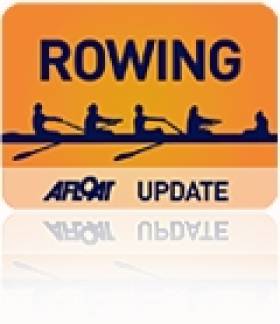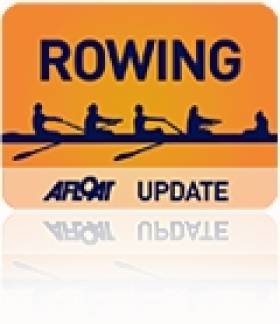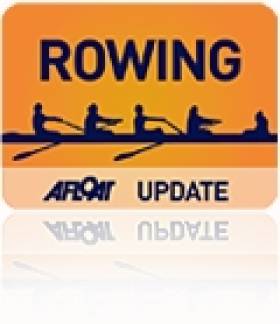Displaying items by tag: European Junior
Ireland Crews Progress at European Junior Championships
#Rowing: Ireland crews hit the mark at the European Junior Rowing Championships at Krefeld in Germany today. The Ireland double of Margaret Cremen of Lee and Aoife Casey of Skibbereen qualified directly for the semi-finals by finishing second in their heat, while the three others made their way through to semi-finals by the repechage route.
The Ireland women’s pair of Gill McGirr and Eliza O’Reilly won their repechage, while the men’s quadruple and pair took second in their reps.
European Junior Championships, Krefeld, Germany (Selected Results; Irish interest)
Men
Pair – Heat One: 4 Ireland (A Johnston, R Corrigan) 7:20.35. Repechage: 2 Johnston, Corrigan 7:24.75.
Quadruple – Heat One: 4 Ireland (J Quinlan, J Keating, M Dundon, B O’Flynn) 6:26.69. Rep: 2 Ireland 6:23.38.
Women
Pair – Heat: 4 Ireland (G McGirr, E O’Reilly) 8:13.17. Rep: 1 McGirr, O’Reilly 7:58.85.
Double –Heat One: 2 Ireland (A Casey, M Cremen) 7:43.43.
#ROWING: The Ireland quadruple finished second in their B Final, eighth overall, at the European Junior Championships at Racice in the Czech Republic today. The Ireland crew of Colm Henessey, Eoghan Whittle, Patrick Munnelly and Andrew Goff had finished sixth in the A/B semi-final. The double of Shane O’Connell and Ronan Byrne were fourth in their C Final, 16th overall.
European Junior Rowing Championships, Racice, Czech Republic (Irish interest):
Men
Quadruple Sculls – A/B Semi-Final One: 6 Ireland (A Goff, P Munnelly, E Whittle, C Hennessy) 6:30.35. B Final (Places 7 to 12): 2 Ireland 6:23.993.
Double Sculls – C Final (Places 13 to 18): 4 Ireland (S O’Connell, R Byrne) 7:16.086.
#ROWING: The two Ireland crews competing at the European Junior Rowing Championships in Racice in the Czech Republic have varying fortunes today. The Ireland’s men’s quadruple scull finished third in their repechag, placing them in the top 12, and qualifying them for the A/B Semi-Finals on Sunday. The men’s double scull finished sixth in their repechage and are set for the C Final.
#ROWING: Ireland’s Eimear Lambe and Jasmine English came within .07 of a second of an A Final placing at the European Junior Rowing Championships in Hazewinkel in Belgium today. The Russia double scull edged out the Irish. Lambe and English later placed sixth in the B Final.
Conor Carmody and David O’Malley won the C Final of the men’s double sculls, placing them 13th overall. They had earlier won their semi-final.
The Ireland junior pair and women’s single competed in C Finals, but were not contenders.Both finished fourth of four crews.
European Junior Rowing Championships, Hazewinkel, Belgium (Irish interest):
Saturday
Men
Pair – Heat Two (First Two Directly to A/B Semi-Finals: 5 Ireland (D Keohane, B Keohane) 7:30.39. Repechage: 5 Ireland 7:34.21
Double Sculls – Heat Three (First directly to A/B semi-finals): 4 Ireland (C Carmody, D O’Malley) 6:56.91. Repechage: 4 Ireland.
Women
Double Sculls – Heat One (First Two Directly to A/B Semi-Finals): 2 Ireland (J English, E Lambe) 7:54.10.
Single Sculls – Heat Three (First Two directly to A/B Semi-finals): 5 Ireland (E Barry) 8:38.33. Repechage: 5 Barry 9:05.20.
Sunday
Men
Pair – C Final (13 to 16): 4 Ireland.
Double – C/D Semi-Final Two: 1 Ireland. C Final:
Women
Double – A/B Semi-Final Two (First Three to A Final): 1 Netherlands 7:19.32, 2 Lithuania 7:24.83, 3 Russia 7:25.57, 4 Ireland 7:24.64. B Final (Places 7 to 12): 6 Ireland.
Single – C Final (13 to 16): 4 Ireland.
Ireland Rowing Crews Find Going Tough in Repechages
#ROWING: The repechage route did not prove a fruitful one for Ireland crews at the European Junior Rowing Championships in Hazewinkel in Belgium. The men’s double of Conor Carmody and David O’Malley were competitve until halfway, but they needed to finish in the top two and missed out by finishing fourth. They will go on to a C/D semi-final tomorrow. The men’s pair of David and Brian Keohane and single sculler Erin Barry both finished fifth. They go directly to their C Finals.
European Junior Rowing Championships, Hazewinkel, Belgium (Irish interest):
Men
Pair – Heat Two (First Two Directly to A/B Semi-Finals: 5 Ireland (D Keohane, B Keohane) 7:30.39. Repechage: 5 Ireland 7:34.21
Double Sculls – Heat Three (First directly to A/B semi-finals): 4 Ireland (C Carmody, D O’Malley) 6:56.91. Repechage: 4 Ireland.
Women
Double Sculls – Heat One (First Two Directly to A/B Semi-Finals): 2 Ireland (J English, E Lambe) 7:54.10.
Single Sculls – Heat Three (First Two directly to A/B Semi-finals): 5 Ireland (E Barry) 8:38.33. Repechage: 5 Barry 9:05.20.
#ROWING: Eimear Lambe and Jasmine English qualified directly for the semi-finals of the women’s double sculls at the European Junior Rowing Championships in Hazewinkel in Belgium today. The Ireland crew finished second to Romania and will compete next tomorrow morning.
Ireland’s three other crews must compete in repechages. The men’s double of Conor Carmody and David O’Malley finished fourth in their heat; while the junior men’s pair of David and Brian Keohane fifth and single sculler Erin Barry both finished fifth.
European Junior Rowing Championships, Hazewinkel, Belgium (Irish interest):
Men
Pair – Heat Two (First Two Directly to A/B Semi-Finals: 5 Ireland (D Keohane, B Keohane) 7:30.39.
Double Sculls – Heat Three (First directly to A/B semi-finals): 4 Ireland (C Carmody, D O’Malley) 6:56.91.
Women
Double Sculls – Heat One (First Two Directly to A/B Semi-Finals): 2 Ireland (J English, E Lambe) 7:54.10.
Single Sculls – Heat Three (First Two directly to A/B Semi-finals): 5 Ireland (E Barry) 8:38.33.


































































